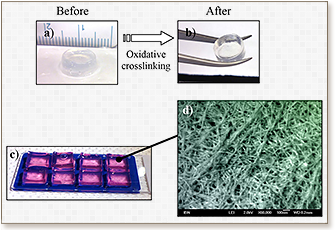
Transparent crosslinked ultrashort peptide hydrogels as a carrier dressing with high shape fidelity to accelerate healing of full-thickness excision wounds
W.Y. Seow, G. Salgado, E.B. Lane, and C.A.E. Hauser
Scientific Reports 6 (2016), 32670

Wound healing is a major burden of healthcare systems worldwide and hydrogel dressings offer a moist environment conducive to healing. We describe cysteine-containing ultrashort peptides that self-assemble spontaneously into hydrogels. After disulfide crosslinking, the optically-transparent hydrogels became significantly stiffer and exhibited high shape fidelity. The peptide sequence (LIVAGKC or LK 6 C) was then chosen for evaluation on mice with full-thickness excision wounds. Crosslinked LK 6 C hydrogels are handled easily with forceps during surgical procedures and offer an improvement over our earlier study of a non-crosslinked peptide hydrogel for burn wounds. LK 6 C showed low allergenic potential and failed to provoke any sensitivity when administered to Guinea pigs in the Magnusson-Kligman maximization test. When applied topically as a dressing, the medium-infused LK 6 C hydrogel accelerated re-epithelialization compared to controls. The peptide hydrogel is thus safe for topical application and promotes a superior rate and quality of wound healing.
DOI: 10.1038/srep32670

"KAUST shall be a beacon for peace, hope and reconciliation, and shall serve the people of the Kingdom and the world."
King Abdullah bin Abdulaziz Al Saud, 1924 – 2015
Thuwal 23955-6900, Kingdom of Saudi Arabia
Al-Haytham Building (Bldg. 2)
© King Abdullah University of Science and Technology. All rights reserved